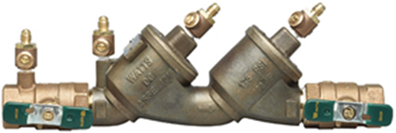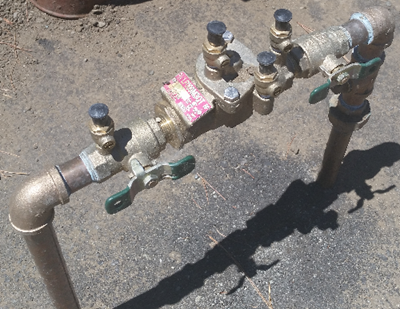§64310. Reduction of Fees for Public Water Systems Serving Disadvantaged Community.
(a) A public water system must pay the full amount of the annual fee unless it requests and receives from the State Board a determination that its annual fees are reduced because it is a community water system that serves a disadvantaged community in which case the fee to be paid is the amount for a disadvantaged community as shown in Table 64305-A.
(b) To qualify for the reduction provided for in subsection (a), a public water system must certify, and provide documentation to the State Board upon request, that it serves a disadvantaged community.
SECTION 1. PUBLIC WATER SYSTEM CONTACTS.
NOTE: A person may be assigned multiple contact types. For example, the owner may also be both the Administrative Contact and Financial Contact.
SECTION 2. POPULATION SERVED.
SECTION 4. GROUNDWATER (GW) AND SURFACE WATER (SW) SOURCES.
SECTION 6. WATER RATES AND DELIVERIES.
Click HERE to see all the help tips for this section.
SECTION 9. CROSS-CONNECTION CONTROL.
 |
 |
| Fig. 1 - a double check valve assembly | Fig. 2 - a reduced pressure principle backflow prevention assembly |
SECTION 10. CONSUMER CONFIDENCE REPORT.
SECTION 11. OPERATOR CERTIFICATION.
This shows the classification of your treatment facility with the highest classification (T1, T2, T3, T4, or T5). However, you may see the following instead:
- "Treatment or Distribution Operator" – your treatment facility or facilities may be operated by either a certified treatment or distribution operator
- "Classification is Unavailable" – the classification of your treatment facility or facilities has not been entered into the Division’s SDWIS database
- No facilities subject to the Certified Treatment Plant Operator requirements – either you do not have any treatment facilities or these treatment facilities are not subject to the certified treatment plant operator requirements.
If you believe that your highest treatment facility classification is in error, please notify your local regulatory agency immediately.
This shows the classification of your distribution system (D1, D2, D3, D4, or D5). However, you may see the following instead:
- Distribution Operator Not Required – your water system is a transient non-community water system and as such is not subject to the certified distribution system operator requirements
- Classification is Unavailable – the classification of your distribution system has not been entered into the Division’s SDWIS database
If you believe that your highest treatment facility classification is in error, please notify your local regulatory agency immediately.
- If you do not have any certified operators to report, put “NONE” in each column of the first row.
Name Grade of
OperatorChief or Shift1 (C/S or X) Operator
NumberExpiration Date NONE NONE NONE NONE NONE - - - - - - Use the following format and rules to complete the State certified Water Treatment Plant Operators table:
1Use “C” for Chief Operator and “S” for Shift Operator. If neither, put an "X". Do not leave blank.Treatment Operator
NameGrade of Treatment
OperatorChief or Shift1 Treatment Operator
NumberTreatment Certification
Expiration DateFirst name Last name 1, 2, 3, 4, or 5 only. C,S or X only (lowercase ok); do not leave blank. 4 or 5 digits MM/DD/YYYY - - - - - - Use the following format and rules to complete the State certified Water Distribution System Operators table:
1Use “C” for Chief Operator and “S” for Shift Operator. If neither, put an "X". Do not leave blank.Distribution Operator
NameGrade of Distribution
OperatorChief or Shift1 Distribution Operator
NumberDistribution Certification
Expiration DateFirst name Last name 1, 2, 3, 4, or 5 only. C,S or X only (lowercase ok); do not leave blank. 4 or 5 digits MM/DD/YYYY - - - - -
SECTION 14. SYSTEM PROBLEMS
SECTION 16. WATER CONSERVATION AND DROUGHT PREPAREDNESS.
SECTION 18. CLIMATE CHANGE.
The State Water Board passed a resolution on March 3, 2017 requiring a proactive approach to climate change in all Board actions, with the intent to embed climate change consideration into all programs and activities. For more information on climate change, please click HERE.
Resources are available that may help you complete this section:
- Access a risk assessment tool, examples of adaptation implemented by different utilities, training, and technical assistance to increase resilience to extreme weather events for drinking water, wastewater, and storm water utilities: https://www.epa.gov/crwu.
- Easy-to-use map of scenarios with a range of projections for each grid cell: https://epa.maps.arcgis.com/apps/MapSeries/index.html?appid=3805293158d54846a29f750d63c6890e
- Climate Resilience Evaluation and Awareness Tool (CREAT) - helps in adapting through a better understanding of current and projected future conditions (requires registration): https://www.epa.gov/crwu/build-resilience-your-utility
- Explore projected changes through the end of the century in California, you can select the location, and period of interest using the online tool: http://cal-adapt.org/
- Quickly and easily identify how climate change could impact water resources in your region, along with a practical checklist: http://www.water.ca.gov/climatechange/docs/Section 4 Assessing Regional Vulnerability to Climate Change-Final.pdf
- See observed and projected conditions in the Southwest, and learn about related topics like extreme events, and adaptation: http://www.globalchange.gov/explore/soutwest